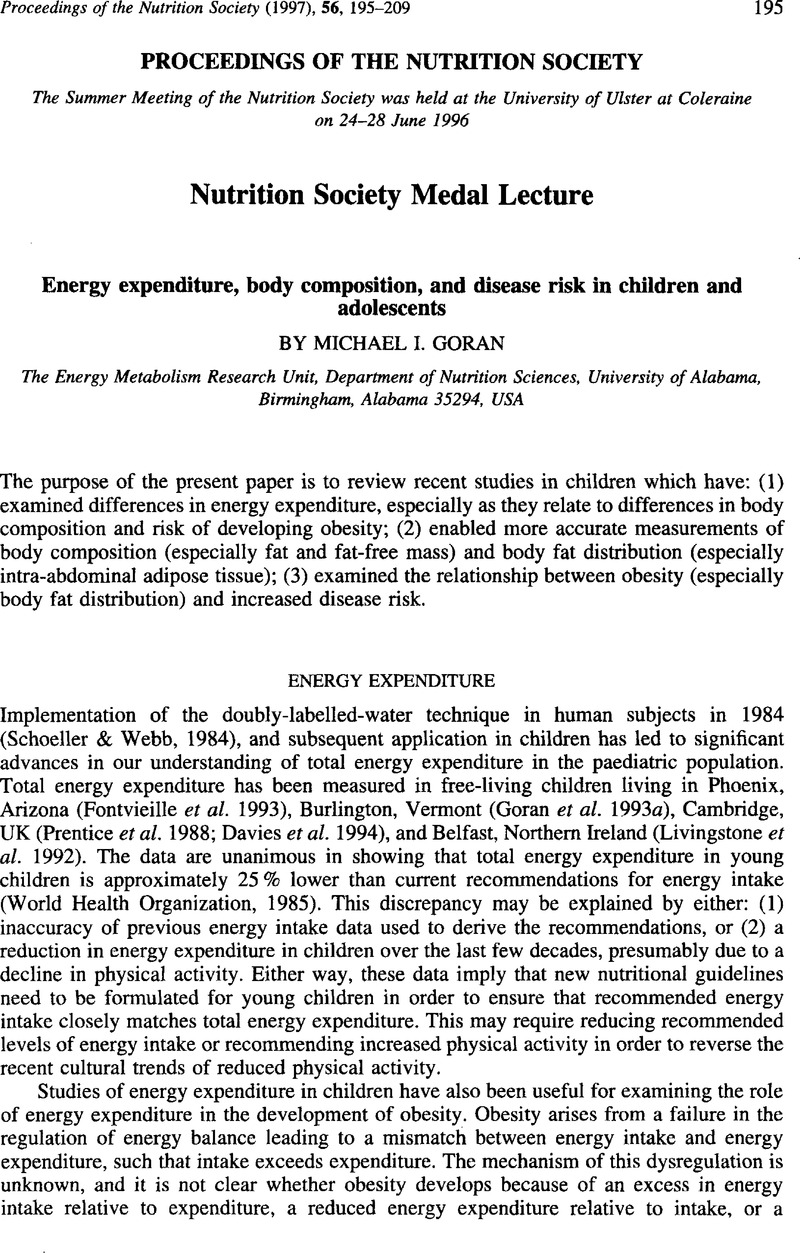Crossref Citations
This article has been cited by the following publications. This list is generated based on data provided by Crossref.
Reilly, John J
1998.
Assessment of body composition in infants and children.
Nutrition,
Vol. 14,
Issue. 10,
p.
821.
Rowlands, Ann V.
Eston, Roger G.
and
Ingledew, David K.
1999.
Relationship between activity levels, aerobic fitness, and body fat in 8- to 10-yr-old children.
Journal of Applied Physiology,
Vol. 86,
Issue. 4,
p.
1428.
Milner, John A.
and
Allison, Richard G.
1999.
The Role of Dietary Fat in Child Nutrition and Development: Summary of an ASNS Workshop.
The Journal of Nutrition,
Vol. 129,
Issue. 11,
p.
2094.
Lenders, Carine M.
and
Lo, Clifford
1999.
Pediatric Parenteral Nutrition.
Nutrition in Clinical Care,
Vol. 2,
Issue. 4,
p.
219.
Styne, Dennis M.
2001.
CHILDHOOD AND ADOLESCENT OBESITY.
Pediatric Clinics of North America,
Vol. 48,
Issue. 4,
p.
823.
Trost, SG
Kerr, LM
Ward, DS
and
Pate, RR
2001.
Physical activity and determinants of physical activity in obese and non-obese children.
International Journal of Obesity,
Vol. 25,
Issue. 6,
p.
822.
Moraes, Cristiane Moulin de
Portella, Renata B.
Pinheiro, Virgínia S.
Oliveira, Marcus M.S.
Fuks, Anna Gabriela
Cunha, Edna F.
and
Gomes, Marília B.
2003.
Prevalência de sobrepeso e obesidade em pacientes com diabetes tipo 1.
Arquivos Brasileiros de Endocrinologia & Metabologia,
Vol. 47,
Issue. 6,
p.
677.
Abbott, R A
and
Davies, P S W
2004.
Habitual physical activity and physical activity intensity: their relation to body composition in 5.0–10.5-y-old children.
European Journal of Clinical Nutrition,
Vol. 58,
Issue. 2,
p.
285.
Treuth, Margarita
and
Bandini, Linda
2005.
Handbook of Pediatric Obesity.
p.
119.
Goran, M.
Cruz, M.
Shaibi, G.
Weigensberg, M.
Spruijt-Metz, D.
Ebbeling, C.
and
Ludwig, D.
2005.
Food, Diet and Obesity.
p.
86.
THOMPSON, ANGELA M.
CAMPAGNA, PHILIP D.
REHMAN, LAURENE A.
MURPHY, RENÉ J. L.
RASMUSSEN, ROY L.
and
NESS, GARY W.
2005.
Physical Activity and Body Mass Index in Grade 3, 7, and 11 Nova Scotia Students.
Medicine & Science in Sports & Exercise,
Vol. 37,
Issue. 11,
p.
1902.
Wilcox, G.
Strauss, B. J. G.
Francis, D. E. M.
Upton, H.
and
Boneh, A.
2005.
Body composition in young adults with inborn errors of protein metabolism—A pilot study.
Journal of Inherited Metabolic Disease,
Vol. 28,
Issue. 5,
p.
613.
Eisenmann, J C
Katzmarzyk, P T
Perusse, L
Tremblay, A
Després, J-P
and
Bouchard, C
2005.
Aerobic fitness, body mass index, and CVD risk factors among adolescents: the Québec family study.
International Journal of Obesity,
Vol. 29,
Issue. 9,
p.
1077.
Cruz, M.L.
Shaibi, G.Q.
Weigensberg, M.J.
Spruijt-Metz, D.
Ball, G.D.C.
and
Goran, M.I.
2005.
PEDIATRIC OBESITY AND INSULIN RESISTANCE: Chronic Disease Risk and Implications for Treatment and Prevention Beyond Body Weight Modification.
Annual Review of Nutrition,
Vol. 25,
Issue. 1,
p.
435.
Goran, M.
Cruz, M.
Shaibi, G.
Weigensberg, M.
Spruijt-Metz, D.
Ebbeling, C.
and
Ludwig, D.
2005.
Food, Diet and Obesity.
p.
86.
Malina, Robert M.
and
Katzmarzyk, Peter T.
2006.
Physical Activity and Fitness in an International Growth Standard for Preadolescent and Adolescent Children.
Food and Nutrition Bulletin,
Vol. 27,
Issue. 4_suppl5,
p.
S295.
Eisenmann, Joey C.
2007.
Aerobic fitness, fatness and the metabolic syndrome in children and adolescents.
Acta Paediatrica,
Vol. 96,
Issue. 12,
p.
1723.
Malina, Robert M.
2007.
Body Composition in Athletes: Assessment and Estimated Fatness.
Clinics in Sports Medicine,
Vol. 26,
Issue. 1,
p.
37.
Eisenmann, J C
Laurson, K R
Wickel, E E
Gentile, D
and
Walsh, D
2007.
Utility of pedometer step recommendations for predicting overweight in children.
International Journal of Obesity,
Vol. 31,
Issue. 7,
p.
1179.
Eisenmann, Joey C
Gentile, Douglas A
Welk, Gregory J
Callahan, Randi
Strickland, Sarah
Walsh, Monica
and
Walsh, David A
2008.
SWITCH: rationale, design, and implementation of a community, school, and family-based intervention to modify behaviors related to childhood obesity.
BMC Public Health,
Vol. 8,
Issue. 1,



